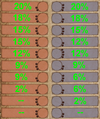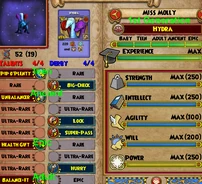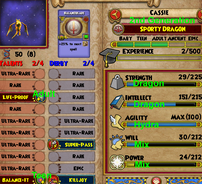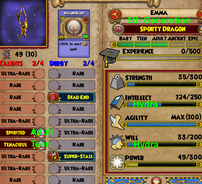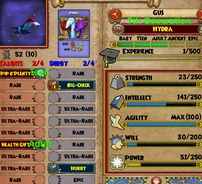This page is for wizards willing to devote a great deal of time and gold to creating a specialized pet beyond what the game initially offers. See Training Pets for less advanced endeavors, and or the Pets page for basic info.
Inheritance
Each egg will be a combination of its parents' traits. How those traits are inherited is different for each trait.
Max Stat Contribution
Each stat's max will either be the average of both parents' max stats (rounded down) or will be contributed directly from one parent or the other. From my observation (from the experiment below and others) two stats are always mixed, two come from one parent, and the final stat comes from the other parent. This may not always be the case, however. Furthermore, the dominant parent (explained below) need not be the parent who contributes two stats directly instead of one.
Boosts to a parent's max stat which it acquired from a learned Talent do not affect the max stat it contributes to an egg. An egg's averaged or directly contributed max stats will be based on the parents' max stats when both parents were hatched.
Talent (and Derby Ability) Contribution
It is difficult to tell exactly how many Talents each parent contributes to each egg, but five from each is a safe assumption, and Talent manifestation so far mirrors the mathematical probability this would imply.
Talents can also be "lost" in a generation, even if both parents have the Talent. If a parent knows Talents A & B, and the other knows A & C, your egg could inherit Talent B from one parent and Talent C from the other. It may never have the ability to learn Talent A. Talent A simply won't be one of the Talents available in its list of Talents to learn, and it can't contribute Talent A to any eggs of its own if it later becomes a parent.
Derby Abilities are contributed the same as Talents.
Dominant Parent
Most pets will hatch as the same breed of, and from the same type of egg as, one of its parents. This is the dominant parent. The dominant parent directly contributes everything that is not a stat, Talent, or Derby Ability. That is, the egg type (evanescent, otherworldly, etc.) time to hatch, breed, physical appearance, card a pet gives, at which level it gives that card, and favorite snacks will all be the same as the dominant parent.
If the dominant parent is a school only pet (i.e. you hatch an Orthrus (Pet) and get a baby Orthrus) the baby will also be school only, and cannot be equipped or trained by any wizard from another school.
Some unique pets, such as many school pet cross-breeds, do not have a dominant parent. They are a unique breed, different from both parents.
Pet Genes
We cannot map the DNA of Wizard101 pets, so pet genes cannot be proven, but there is a great deal of data to support their existence. While the Talents and Derby Abilities a pet learns as it levels appear totally random, they are more likely only partially random. Pets several generations down the same family line show a propensity to learn the same Talents, and not to learn others.
The image to the right is a composite of 36 Talents and 36 Derby Abilities, all learned by 7th & 8th generation pets within the same family line. The rarity of each Talent and Derby Ability is indicated to show it does not seem to affect the propensity to learn them. The mean for random abilities should be roughly 10%. As you can see, some are much higher than that while others are much lower. This is a good example of evidence of pet genes, though different family lines may show a different composite.
Pet genes are good news to trainers wishing to hatch a pet. If you want an egg with specific Talents, and each of these Talents has already been learned by one or both of the parents, the Talent is more likely to manifest in the egg.
Pet genes do not seem to affect the inheritance of individual Talents, but they do make the pet more likely to learn certain Talents when those Talents have been inheritted. A random element definitely still exists, however.
7th Generation Pets
Designer pets! This is a method for merging two pets into one, so called because the average process will take seven generations (counting both parents as your first generation) though it may take more or fewer generations based on your luck. In-breeding is usually a bad thing, but it works to our advantage here.
For example, if a Life wizard wanted a Sturdy Dragon for its Dryad Item Card, but wanted the player-boosting Talents of his Satyr (Pet), he could begin hatching them. Within about seven generations, he should have a Sturdy Dragon with Satyr stats and Talents, which will give him the same Life boosts any Satyr could.
7th gen pets are not for the faint of heart. Expect the full process to take about a month if you play several hours a day, and around half a million in gold, not including the snacks you'll need. Lucky players may get the eggs they want more often, making the process faster and cheaper. Unlucky players, not so much. Plan to endure a number of crushing setbacks. When it happens, take a few days to catch your breath, then attack it again. If friends can't hear your name without thinking the words "crazy" and "stubborn", you have a good chance to succeed. Eventually.
The Experiment
Don't worry, the experiment was a complete success. Don't let the word deter you. Copious notes were kept throughout, so following the steps of the experiment will help to illustrate the full process of 7th gen petting.
Milestones are important to ensure you're on the right track. It's also a good idea to reward yourself each time you hit one, as your motivation will need the boost at times.
- Have a Reason
- Get the right parents
- Get the right egg
- Clone the stats
- Clone the Talents (not necessarily the pedigree)
- Train your pet
It seems simple, but determining a reason is the most important step. With the time and energy we're devoting to this, it's suicide if you don't have a good reason to do it. It's also a lot of wasted time and effort. Many wizards simply won't have the need for a 7th gen pet, or the benefits they'll get are not good enough to justify the time and effort.
My Balance wiz performed the experiment. Every school has its bad cards, but Balance is full of them. The Hydra Item Card isn't the worst, but it's disappointing to train a Hydra (Pet) to Epic with nothing better than that in your deck to show for it. With no convert available vs. the big Balance bosses, Spectral Blast deals damage faster and more efficiently than a standard Hydra (Spell). Even the Hydra item card only beats Spectral Blast 1/3rd of the time (when it's ice) and only on the first attack, after which a lot of her traps are gone. Hydra takes too long and relies on finding too many traps in her deck to set up properly, it eats her Feints and traps like popcorn, and the pet simply looks a little ungainly. (I do love her, but she's a pet that only a mother could love.)
A dragon, on the other hand, in copper and gold is pretty stylish. Enter the Sporty Dragon, offering a Balanceblade Item Card which stacks with her normal Balanceblade, effectively making every Judge in her deck an item card. Or can be used with an item card Judge for even more damage. With that, grand gear boosts, and Feint in her deck, Jotun dies in one hit (9235 damage to be exact). Balance doesn't have many traps and shields available to boost its own attacks, so this is a pretty huge deal.
Some pets offer the Dragonblade Item Card for even more damage, but we don't have access to those pets and couldn't find anyone willing to hatch one. Also, the Sporty Dragon really is very pretty.
- Milestone #1 complete: we have one HECK of a reason.
Now we need the parents. Our Balance wiz already has a Hydra (Pet). One parent down. Breeding with a friend to get a Sporty Dragon will work (it will also prove that the dragon can be bred, which will help with milestone #3). In this case, we just coughed up the coin for a gift card from Toys R Us.
- Milestone #2 complete:
Now it's important to make sure your parents can make the egg you need. This usually isn't an issue, but some parent combinations may not necessarily give you the egg you want. In this case, we want a Sporty Dragon which hatches from a lifebloom egg. We're lucky (which is good, because we won't stay lucky for long in this experiment) and we get one first try.
- Milestone #3 complete:
Now we get down to the dirty work, hatching, training, hatching, training, and more hatching and training. Figuring the mathematical probability, the average process will complete milestone #4 by the 5th generation. Again, our experiment supports our theories. You can follow the progression of the max stats below. (You can also follow the progression of the Talents, for milestone #5). Keep in mind several of the max stats shown are boosted by Spirited and Tenacious, which do not count toward inheritance.
- Milestone #4 complete: Emma, our 5th gen dragon, has Hydra stats.
The next step is to clone Hydra's Talents to the egg. It is important you pay special attention to the Talents of the egg and of the parent whom you want to donate the Talents. Ignore the pedigree. You want to ensure the Talents mirror each other in order. So far, our eggs have had rare Talents in slots 2-4, while Hydra only has rare Talents in slots 2 & 3. It appears we have the Talents duplicated in our 6th gen dragon below, but we won't know for sure without training her.
Here we must also consider "recessive Talents". Let's say those three rare Talents in a row on our 5th gen dragon are Talents A, B, and C. We want to keep A and C, but not B. Let's say we train our 6th gen dragon, who only shows two rare Talents in a row. We find the first is A, which is good, but she never learns the other. She knows A/?. Our 7th gen also has two rares in a row so we train her. Her second rare is C, which is also good, but she never learns the first. She knows ?/C. We can't put the two pets together and assume the 7th gen's ?/C is A/C just because the 6th gen's were A/?. The 6th gen could have had A/B, donated B while they Hydra Donated C, and 7th gen's ?/C may actually be B/C. This could go on for generations: A/B, B/C, A/B, B/C. You'll know B is there when one of the generations learns it, but you can't know that it ISN'T there.
The only way to prove an egg does not have a recessive gene is to breed it outside the current "gene pool", in other words to breed it with another random pet, preferably one that is cheap to breed. Train the eggs from that pairing until you see which abilities manifest. In this case, if the outside-gene-pool eggs (any of them) learn A & C, and the outside-gene-pool parent isn't capable of learning either, then we know our 7th gen's ?/C is actually A/C. However, if Talent B manifests in one of the outside-gene-pool eggs, we know the recessive Talent is still in the gene pool.
The theory of pet genes can actually hurt you here. As you can see from all the pets in this experiment, none of them learn the rare Talent in Hydra's slot #2 (Add Balance--no, the Wiki doesn't reflect that, we're just really sure that's what it is for a post-pet-update Hydra). Our family line does not have the genetic propensity to learn this Talent. Therefore, outside-gene-pool eggs will be less likely to learn it, making it harder to prove what Talent fills that spot.
As you can see, it's a lot more work just to verify that the recessive gene is gone. Furthermore, it's unnecessary work and partially duplicated. By spending your gold and pet energy to continue the 7th gen process down the chain of generations, you can't prove the recessive Talent ISN'T there, but you will prove it IS still there if it ever manifests, while at the same time working to eradicate the recessive Talent with each generation.
- Milestone #5 complete:
As explained above, Sadie looks like a Hydra. (She's also Ancient instead of Adult, because this is the second time during the experiment I got nothing but Hydra eggs for a week, so trained up the current dragon to take the edge off my frustration. You'll have setbacks in this process, be prepared.) It appears we've cloned the Hydra's Talents, but it's a good idea to give it one more generation before we devote a week and all those snacks to training this one to Epic. Also, if the next generation is also a duplicate, it makes more sense to train that one to Epic instead, as there's a better chance recessive Talents will be eradicated with each generation.
It's also good in a 7th gen experiment to continue all the way to the 7th generation. I'd be letting you guys down otherwise.
- Milestone #6 complete:
We've hatched her, trained her, and our 7th gen dragon (Boomer) not only gives us a Balanceblade Item Card but two awesome Balance boosts to accuracy and resistance. She's also adorable and gets plenty of comments from our friends. She doesn't boost power pips for Judge, so our Balance wiz is going to keep at it for a few more generations, but the experiment is complete and successful. And as you can see from one of the 7th gen Hydra "duds", the family line still gives power pips:
Now if you'll excuse me, Sadie's and Boomer's first egg didn't have Balance-It and Pip O'Plenty by Adult, and I'm confident their genetic propensity will get such an egg within a few tries, so I have some farming to do. Have fun with your pets!
